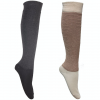
Socks help prevent painful skin tears
Researchers at The Royal Devon and Exeter Hospital say the use of simple, specially developed protective socks could help thousands of older people in the UK who suffer from a debilitating skin condition.
The STOPCUTS pilot trial monitored the effects of wearing the socks on volunteers prone to skin tears, a common problem in the over 65’s.
A skin tear involves a piece of skin being peeled back to varying depths by a knock or scrape and occasionally leaving a flap of skin. This can sometimes be put back by doctors, but on occasion, the top layer of the skin is completely lost.
The tears are the result of thinning skin receiving even minor knocks from blunt objects and are painful, prone to infection and sap the confidence of the sufferer. If left untreated or incorrectly dealt with, tears can develop into painful leg ulcers which take a long time to heal, can lead to a loss of mobility and are costly to the health service.
The pilot study has been funded by the National Institute for Health Research under their Research for Patient Benefit scheme. Its purpose was to establish whether this type of research could be done at all in an older population in Devon, including residents in care homes.
Lead researcher Doctor Roy Powell, says: “This is very much an overlooked area of health care. No-one really knows the true incidence of skin tears in the UK, but we estimate from local GP audits about 1,300 per 100,000 of the elderly population per year are affected and this figure has serious health implications. We know that treating skin tear injuries is the most common activity that community nurses offer.
“Skin tears are graded from one to three, according to their severity, with the worst level often requiring a skin graft. We think some skin tears turn into leg ulcers in patients with leg veins that don’t work very well, in that they are not efficient in returning blood to the heart”.
“Ulcers are very difficult to treat and the patient often has to wear special compression bandages, which have to be changed frequently for weeks on end.
The community nursing bill for treating patients with skin tears and also those with leg ulcers is over £1.5 billion, so prevention could save the NHS a lot of money.”
The results of the pilot study have been welcomed by the Government.
The Minister for Life Sciences, George Freeman, MP, says: “Research in NHS hospitals benefits NHS patients. This exciting trial could help prevent thousands of older patients from needing to undergo treatment for painful skin tears and leg ulcers, and could help save time for hardworking community nurses all over the UK. That’s why we have committed to invest £1 Billion every year of this Parliament in NHS research through the national NIHR network of research centres, funding world-class research to help NHS patients and avoid unnecessary treatment costs.”
The Dermatuff socks have been designed by East Devon businessman, Peter Thornton, the former chairman of the Thornton’s chocolate firm. He came up with the idea after suffering from painful skin tears on both his arms and legs. Peter teamed up with Plymouth-based entrepreneur, Nick Pitts, to found Dermatuff. Over the past 12 months, the internet-based company has seen a jump in sales and has expanded its market to the United States, Canada and Australia.
The knee-length socks are manufactured with Italian light-weight yarn, reinforced with Kevlar® by DuPont, a protective material used in the manufacture of stab-proof vests and other light-weight body armour worn by the police and the armed forces.
Ninety volunteers were recruited for the pilot study – 54 of them were from care homes and the remainder came from GP practices in the East Devon area.
The participants were divided into two groups at random to either wear Dermatuff socks on a daily basis or go into the control group who wore their usual clothing. The trial lasted for 16 weeks for all participants. Care home staff and research nurses then photographed, measured and graded the severity of all skin tear injuries that occurred in the two groups.
At the end of the trial period, it was recorded that 10 tears occurred in 8 out of 44 people in the group wearing the Dermatuff socks. However, 8 of these tears happened when the participants were not actually wearing the socks, meaning that only 2 of them occurred when protective socks were being worn and these were small Grade 1 tears (about 1mm across). In the control group, 21 tears occurred in 10 out of the 46 participants who were all wearing normal clothing and not the protective socks.
Doctor Powell says: “The tears sustained by the control group were larger and more severe, with more patients having repeated tears. One patient had 8 separate injuries in 16 weeks. These are only early, pilot results and need to be confirmed by doing a larger trial, probably containing a few hundred participants.”
Peter Thornton says: "We are delighted that the Skin Tear Protection socks and sleeves achieved a high level of protection for the 44 participants in the user group of this pilot study. Statistics from other parts of the United Kingdom back up the findings from the team at the R D and E. In 2007, The International Wound Journal published research carried out in the Hull and East Riding area of Yorkshire into the cost of wound care locally. It showed that in 2005-2006, this was up to £3 Million per 100,000 of the country’s population.”
Doctor Powell is writing up his findings in a research paper.
He now plans to obtain research grant funding for the larger trial involving hundreds of patients from Exeter and East Devon and also from Bristol.


















